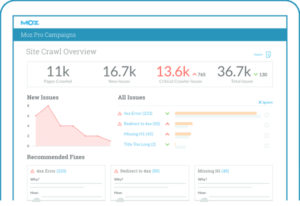The First Six Steps to SEO Success
SEO has long been shrouded in mystery. We’ve heard it described as a “dark art”, the “wild west” and “all cloak and dagger”, but it needn’t be any of that.
For many marketers, especially those in niche industries, getting the basics right will have a vast impact on their positions on the search engine results pages (SERPS).
Big or small, established or new, here are the first six steps we take to put any client on the road to SEO success.
1. We Make a Business Case for SEO
Our clients often like to understand what they can expect to see from their SEO investment. Based on their budget and our research, we work with them to set KPIs on SERP positions, traffic etc. – but many clients want to get a feel for their potential financial return too. If this is the case, we use a simple formula to give our ecommerce clients a rough guide to the difference we could make.
We assume 30% of total search traffic for any keyword will click on position one on Google. Let’s say the client’s keyword in question has 900 searches a month (and we are not currently ranking for it on Google page one), getting the top slot would get circa 300 extra visitors to our website a month. We then take the conversion rate (CVR) of the site, and the average order value, to calculate a potential revenue. In other words:
300 extra users x 1% CVR = 3 conversions
3 conversions x £100 average order value = £300 extra revenue from SEO a month
2. We Perform a Site Health Check
Assuming the client is happy with the business case for SEO, next we check there are no serious technical issues on their website.
Tools like Moz and SEMrush help tell us what we need to do in order to improve the performance of any website, from fixing broken redirects to missing title tags, and more.
We sort any major issues – this sets a good a base for future work as well as showing Google that the client regularly maintains and improves their site. We often even get a small ranking boost in the weeks that follow.

3. We Decide Which Keywords to Try and Rank For
The biggest mistake most marketers make with SEO is having too much of a blinkered view on the keywords they want to rank for, opting for say trainers, which is hugely competitive (i.e. expensive), and not thinking wider e.g. men’s trainers, ladies’ trainers, white trainers, cheap trainers etc.
As a general rule of thumb, keywords with the highest search frequency actually have a lower search intent. The more people refine their searches, the closer they come to taking an action/making a purchase. Better still, keywords with a lower search frequency are often easier to rank for, requiring on-page work only – in other words, you might not need to invest in a link building campaign.
So, we start our keyword research by working with the client to define the product or service names we think they should rank for. We enter those into the Google Keyword Planner and will be able to see how many people search for those phrases in particular. We are also given a long list of other keywords to consider. Note: if you are spending with Google, you will get more detailed information on search volumes.
4. We Always Check Out the Competition
Next, we have a look at which websites are performing well for the keywords we want to rank for. If they have a high domain authority, we know we might struggle to beat them with on-page work alone, so we check out their domain authority on the Moz bar.

5. We Create a Site Map
Once all of the above is done, and we know which keywords we wish to rank for, long and short term, (bearing in mind search volumes, budget, competitiveness and intent), we sketch out a site plan, grouping keywords together and ensuring we have pages with ample content to signal to Google that our clients are the experts in that area. Our copywriters highly recommend plugins such as Yoast when it comes to content creation for SEO.
6. We Analyse Performance
We measure and report on a long list of metrics, starting with SERP improvements – in other words, how visible the site is in the top 100 search results. SEMrush and Moz’s project domain tracking tool are perfect for this.
We measure general traffic uplift via Google Analytics – this includes users, new users, sessions and page views.
We monitor specific keywords, again using Moz or SEMrush, and use a combination of Google Search Console and Google Analytics to see which keywords have generated the most traffic and conversions.
Once the on-page work is well underway, we may then start a digital PR campaign to address off-page elements, which become ever more important as we look to increase our positions on the SERPS for the higher volume / more competitive keywords. For more information on digital PR, who needs it, and why, please click here.
The author was a past Senior Search Marketing Manager at WPR, specialising in technical SEO, PPC and content strategies.
